Warli Art: A Reflection of Culture and Lifestyle of the Warli Tribe
|
Table of content: |
Warli Art is an age-old, unique, and culturally rich art form of the indigenous tribes of Maharashtra & Gujarat that dates back to 2500 years ago. The art specifically symbolizes the lifestyle, rituals, and traditions of people of the Warli tribe. The art form gives a minimalist depiction of the daily life with nature at its heart using geometric shapes.
This blog explores the cultural and lifestyle reflections in Warli art, how it has evolved, and its place in today's modern art.
A glimpse of Warli Tribe
The Warli tribe is one of the oldest and most distinguished indigenous tribes of India. The name "Warli" is said to have originated from the word 'warla', which refers to a piece of land in the local dialect.
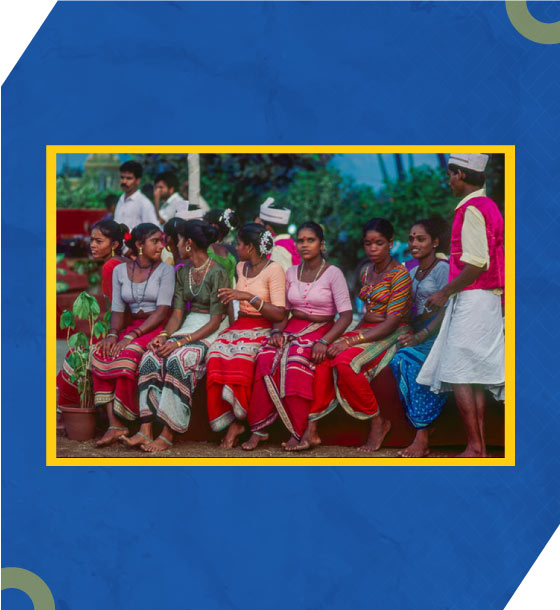
A group of females belonging to Warli tribe in their traditional attire (image source: Google)
The traditional habitat of this tribe lies in the forested regions of the Sahyadri range of mountains, which range across Maharashtra and Gujarat states. The major mode of lifestyle was agriculture-based, as they resided in minor villages and subsistence cultivation was predominantly carried out based on rice, maize, or vegetables.
Blended in simple living, the Warli people traditionally stay in mud huts, decorated with their signature Warli art, which beautifully portrays their way of life, nature, culture, and beliefs.
Origin of Warli Art
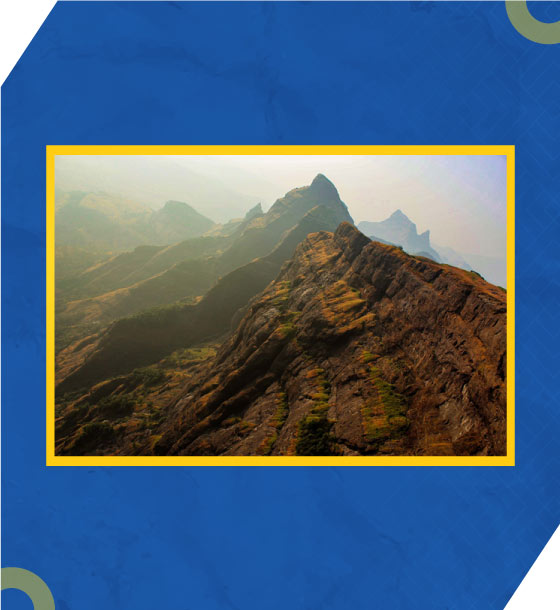
Sahyadri Mountain Ranges in Maharashtra & Gujarat (image source: Google)
Warli Art is the traditional art used by the people belonging to the region of Sahyadri range of mountain in Maharashtra and Gujarat, who are considered to be one of the oldest tribes of India. Their art reveals glimpses of their life that revolves around agriculture.
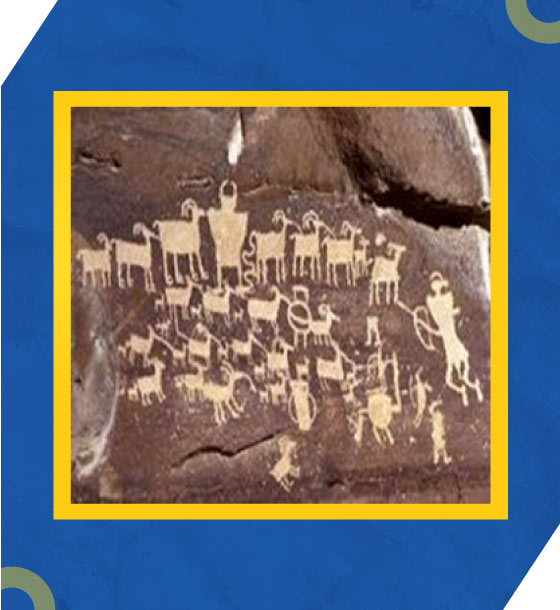 Prehistoric paintings on rocks resembling Warli Art (image source: Google)
Prehistoric paintings on rocks resembling Warli Art (image source: Google)
Warli art bears a striking resemblance to prehistoric cave paintings. As noted in Yashodhara Dalmia's Painted World of the Warli, the origins of this art form dates back to 2500–3000 BCE, with its visual style strongly reflecting its ancient, prehistoric roots.
One can still view the spectacular Warli paintings in the caves of cities such as Dahanu, Talasari, Jawhar, Palghar, Mokhada, and Vikramgad, located in the Palghar district of Maharashtra.
Unlike many Indian art forms, Warli art is not derived from mythology or religion. It instead takes inspiration from the community's daily life and catches key aspects of tribal life such as hunting, sowing crops, and celebrating harvests. Some paintings also show rituals, festivals, ceremonies, and the deep connection the tribe shares with the wildlife surrounding them.
Warli Painting on Wall
Traditionally, Warli paintings were done on the walls of homes or communal spaces using natural materials like red ochre as a base coat and white rice paste, seldom adding cow dung in it.
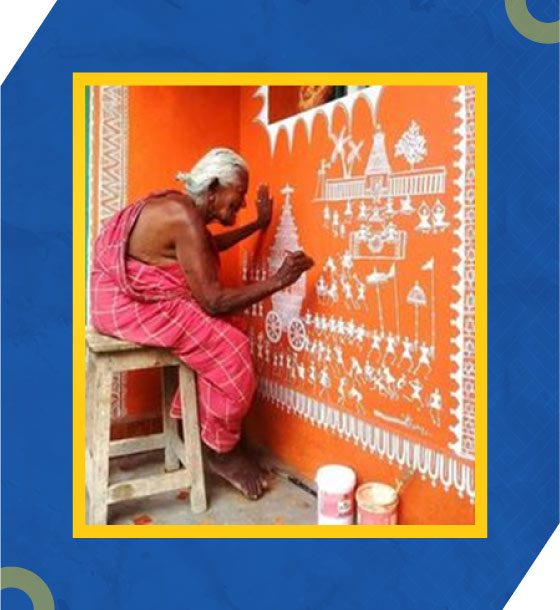 An old woman drawing Warli painting on her house wall(image source: Google)
An old woman drawing Warli painting on her house wall(image source: Google)
These paintings were mostly temporary and used to get washed away after some time, which is why much of this artwork has been lost over the years.
However, this practice continues in some parts of India like the Dang and Valsad districts of Gujarat, maintaining the traditional art form alive, where the Warli tribe still create murals on the walls of their homes during festivals and significant occasions.
Warli Painting on Canvas
Traditionally, rice paste was used as paint on house walls, but modern practices have shifted toward using acrylic paints on canvas or other suitable materials, offering greater durability and ease of application.
This adaptation enables contemporary artists to easily retain and exhibit their artwork. Warli paintings on canvas can be located in galleries, homes and exhibitions around the world, presenting an international appeal to art forms while maintaining its origination in tribal culture.
Key Features of Warli Art
Geometric Simplicity: Warli paintings have a unique aesthetic appeal to them, which rests purely on basic geometric shapes such as circles, triangles, and squares. These geometric shapes are used symbolically to denote natural elements, daily life of humans and their activities and sometimes even the life cycles.
Earthy colour palette: Traditionally, Warli paintings are painted on a mud wall or a red ochre background by using white pigment made from rice paste. The contrast of the sharp white colour against the earthy background is what brings out the art.
Art Themes: Warli art is, at its very core, an expression of the tribal lifestyle. It is rich and deeply rooted in the tribe's connection with nature. The paintings are mostly nature-centric suing elements of nature in it like animals, birds, trees, and natural scenes.
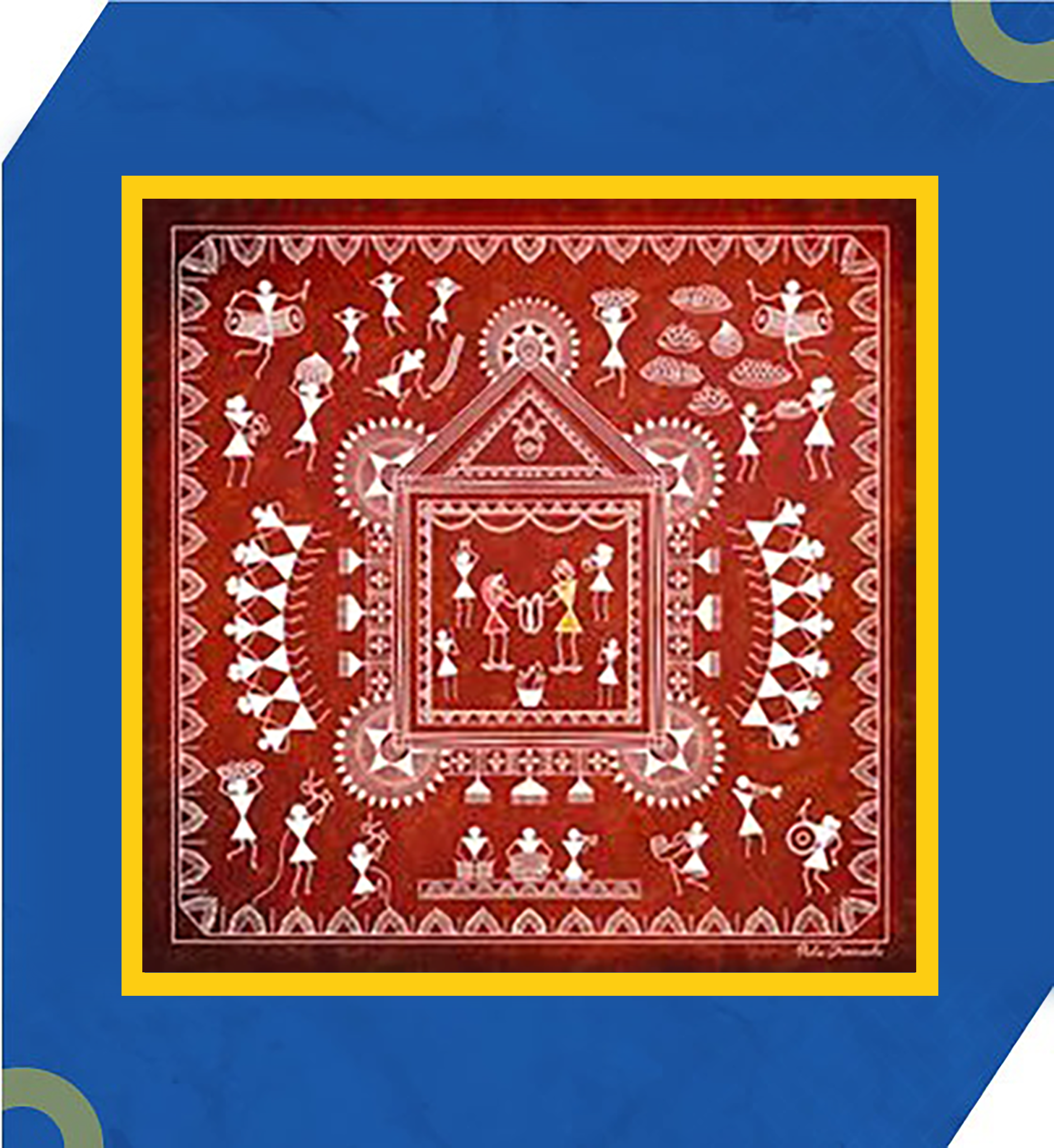
A painting depicting local wedding celebration.
Mundane life of Warli tribe is also used as one of the themes for painting. Everyday routine with men and women working, dancing, celebrating, or scenarios which represent their community rituals and festivals are often depicted in these paintings.
Warli paintings are also based on agriculture as one of the main themes, depicting field activities like sowing seeds, ploughing, harvesting crops, and so on. Such visuals often reflect the relation between the tribe and the earth and their respect for the cycles of nature.
Depictions of Humans and Animals: Warli artworks feature stick-like human figures, often composed of two inverted triangles and a circle, alongside depictions of domestic animals like cows, goats, hens, and horses using simple lines and shapes to portray daily life scenes.
It also presents a harmonious relation with the wildlife and nature among the tribe.
No Facial Features:Human figures in Warli paintings are drawn without facial features. This simplicity in paintings is symbolic of the connection between the tribe members and the community rather than focusing on individual identity.
Narration Aspect:Each painting gives a story, either telling the rituals, festivals, or daily activities among the Warli tribe. They have been a source of their culture, lifestyle, and belief practice as a visual representation.
Spiritual Symbols:Although Warli art does not show gods or deities as most other traditional Indian art forms do, it is a ritualistic and ceremonial art-form. The art often contains symbolic representations of life forces like fertility, harvest, and the cycle of life and death.
Community and Rituals:Warli paintings often showcase communal activities, such as harvest festivals, marriage ceremonies, and celebrations, reflecting the social cohesion and cultural beliefs of the people of Warli tribe.
Cultural Preservation:Originally painted on mud walls of huts, Warli art is now created on various surfaces like canvas, paper, and fabric, ensuring its preservation and wider appreciation beyond the tribal community.
The Evolution of Warli Art
Although the themes and style have stayed somewhat constant, the materials and surfaces changed a bit with time. The use of acrylic paint with a brush on a wooden board or paper is prevalent for Warli artists in these contemporary times. Fashion has also come in and found a space by having Warli motifs adorning textiles, clothes, and accessories.
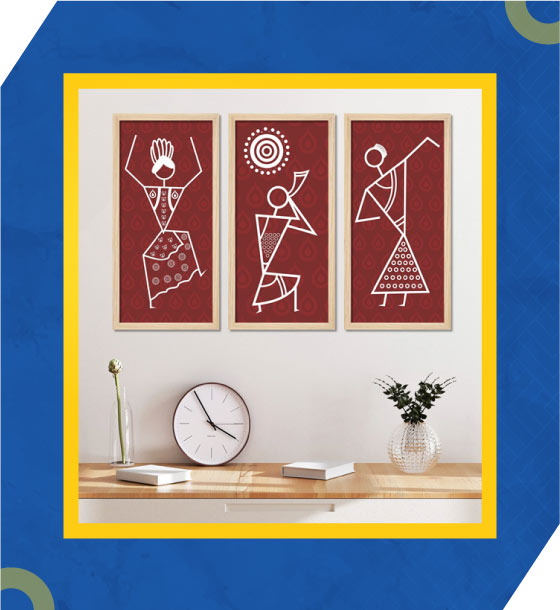
Warli paintings used for indoor decoration and aesthetics (image source: Google)
The growth of Warli art as a commercial venture has also given the Warli tribe greater recognition. Many tribal artists are now able to showcase their work at art exhibitions and festivals and receive national and international acclaim.
And it won’t be wrong to say that Warli art is not just a tribal tradition anymore but a thriving form of contemporary Indian art.
In conclusion, Warli art is not only an art expression but also a reflection of the culture, traditions, and lifestyle of the indigenous Warli tribe. Their precious art talks of the connection between the people of the indigenous tribe with land, animals, and with each other in terms of symbiotic relationship. As Warli art becomes increasingly popular and more globally appreciated, it becomes an icon that showcases India's deep rich culture and the time-honoured relationship between human beings and nature.
Whether on mud walls or canvas, Warli paintings captivate art lovers from every corner of the earth reminding us how simple and beautiful and united the nature is.
FAQs
Q. What is Warli art?
A. Warli art, practiced by the Warli tribe from the Sahyadri Mountain Ranges of Maharashtra and Gujarat, expresses the deep connection of the tribe with nature, animals, and community life. Represented by simple shapes such as triangles, circles, and squares, the art represents their day-to-day life. Earlier applied on walls, now, Warli art is quite famous all over the world in the form of canvas, cloth, and other things.
Q. What is the concept behind Warli art?
A. Warli art basically shows that the Warli tribe feels a deep connection towards nature, wildlife, and farming. It also indicates their day-to-day activities and the rituals of the community and festivals and celebrations too. The simple shapes of triangle, circle, and squares in form, each shape and each form have a symbolic meaning.
Q. What are the origins of Warli art? Can we see it today?
A. Warli art is from Sahyadri range, a range of mountains crossing Maharashtra and Gujarat in North Indian Territory. The art takes the resemblance of pre-historic cave paintings and starts its history back to the 2500–3000 years BCE. This ancient artwork maintains its visual look as something very old.
Even today, one can see beautiful Warli paintings in caves across Dahanu, Talasari, Jawhar, Palghar, Mokhada, and Vikramgad, which lies in Maharashtra's Palghar district.
Q. What is used in making Warli paintings?
A. Traditionally Warli paintings were done on mud walls with rice paste and cow dung whereas now days acrylic paints on canvas or other materials are used to save time in preserving and showcasing the artwork in galleries and exhibitions.
Q. What does the symbols in the Warli Art mean?
A. Warli paintings are rich in symbolism. The geometric shapes used in Warli art are not simply artistic tools but carry significant meanings. For example, the circle represents the cycle of life and death and the oneness of nature, the sun, and the moon. Triangles are associated with mountains and trees, and human anatomy symbolizing the tribe's connection to the earth and its resources. The square represents the human world and community, often depicted in the center of a painting to represent harmony and togetherness.


Related Blog